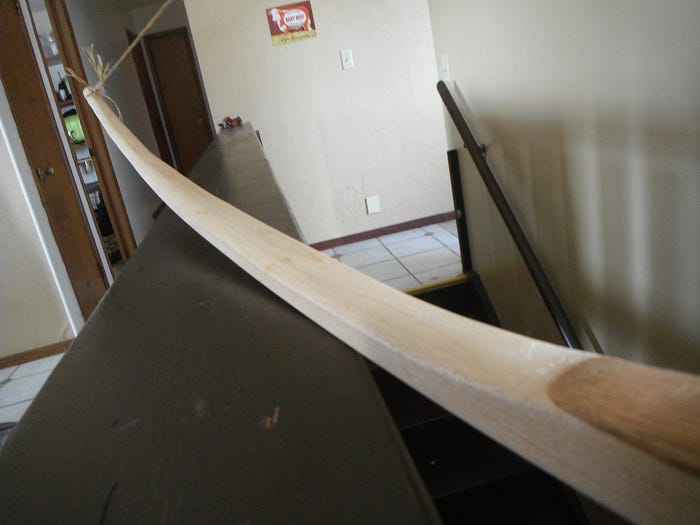Building a Wood Bow
Species Selection
For many years it was assumed that only a couple different species of wood was suitable to make a wooden bow. But much research and experimentation in recent years by bow makers all over the world have shown that a bow can be made from almost any type of wood. What matters the most when it comes to selecting a species is that you know what kind of bow you are going to make. A very heavy English style longbow puts different demands on a piece of wood than Mongol recurve bow. So knowing what you are going to make is critical when selecting the wood.
Since longbows are my specialty I will briefly go over what types of wood can make a good long bow that can be used all the way from target shooting to hunting large game.
Soft Maple Longbow D-Cross Section

The Best
There are two types of wood out there that are acknowledged across the bow making community to be among the best woods to make a bow with,
- · Yew
- · Osage orange
Yew
Yew was made famous as a bow wood during the Middle Ages because it was the wood of choice to craft the infamous English war bow. This style of bow was used to devastating effect against the enemies of England during the Hundred Years war. It was the bow wood of choice because of the naturally occurring laminate that forms within the wood as it grows. This lamination of a flexible strong in tension sapwood with a strong in compression heartwood makes the yew the wood of choice for many bow makers.
Osage Orange
Osage orange is also well known for being an excellent bow wood and its fame is derived from accounts of Native Americans using it to craft their excellent flat bows from. It grows primarily in Texas, Oklahoma, Arkansas and Louisiana in river valleys and hedgerows.

The Good
Despite the dominance of yew and osage orange in the hearts and minds of many bowyers out there are many species that can still make a quality wood bow. I personally have only dealt with a few of those species so my list is not exhaustive but is merely a reflection of my experience.
- · Hickory
- · Ash
- · Red Oak
Hickory
I personally am a huge fan of hickory for a couple of different reasons. It is tough springy wood that can take a lot of abuse both when you are making something with it and afterwards when you use it. It can be very easy to work and shape assuming you have sharp tools and you are not fighting the grain at all. You can also make high lbs. bows with this wood with very little fear of unexpected breaking. I personally have made bows with a 70 lb draw weight and it performed flawlessly for a whole day of competitive shooting. The final thing that I really like about this wood is how common it is. I get all my staves from the local Menards for around 6 dollars and I can usually find at least 1 or 2 bow worthy staves in the lumber stack each time I check.
Ash
Ash is another great contender for making a longbow out of. I have found personally that ash really takes to the flat bow design verses the D cross section English style bow and is a very reliable and easy to work wood as well. It can be harder to come by than either hickory or red oak because it is not commonly carried in most lumber yards. The other downside is the fact the USA ash trees are being decimated by an invasive pest called the Emerald Ash Borer which over time will completely kill our large ash trees.
Red Oak
I once read that if archaeologist in the future ever does research into what types of wood were prized to make bows from they will most likely conclude that red oak was our favorite. While any bowyer who knows wood would not put this one at the top of their list they will admit it is very easy to find and work with. Red oak is a great starter wood because of its cost and universal availability. It also tends to have favorable grain patterns which make finding usable staves easy. This particular wood is good for lower weight target/hunting bows of 45 lbs. or less. You could use it as the belly of a composite or laminated bow with a hickory or bamboo backing to make a heavier weight bow if you would like.
The Ok
I have only worked with one wood that would be considered ok by most bowyers and that is soft maple. Soft maple is really easy to work with and can make a decent low weight bow of 40 lbs. or less. In my experience it does have the tendency to get quite of bit of string follow at the tips so care has to be taken with design and storage. I mainly like to use maple as either a riser piece to build up the grip or as a backing material for bows with less than optimum grain.
The species that I have briefly detailed are just a few of what can be used to make a bow from. Each species of wood has very different growth pattern and wood characteristics that make each one suitable for a different style of bow and it is up to you as the bowyer to understand what species work better with different designs. This knowledge mainly comes with lots of trial and error with the use of many different types of wood and bow designs.
Stay tuned for other articles on Building a Wood Bow.
For more information check out the Traditional Bowyers Bible
